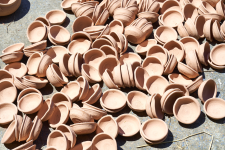
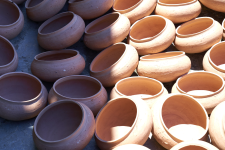
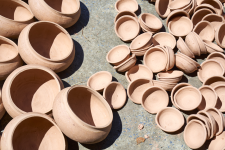
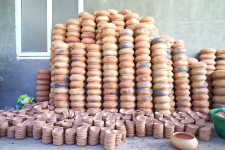
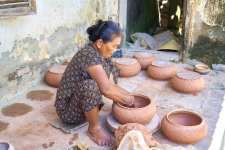
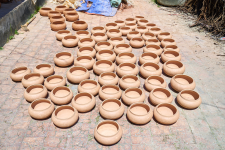
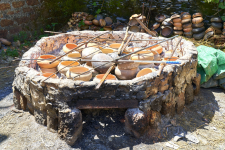
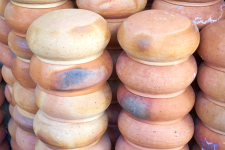
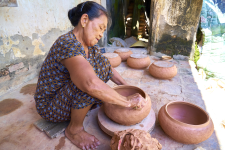
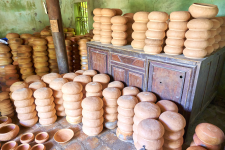
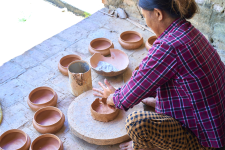
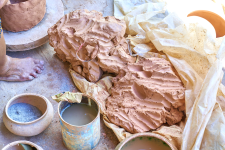
Camera tour
Price: Free
Time to visit a place: 120 phút
Open Time: 7:00 AM - Close Time: 6:00 PM
Address: Tru Son Village, Do Luong District, Nghe An Province
TRU SON POTTERY VILLAGE – DO LUONG DISTRICT
Tru Son village, also known as clay-pot village, formerly belonged to Tru U, 20km southeast of Do Luong town, Nghe An province. This is the only area where clay-pots are made in Nghe An and it is also a rare place in the country that still maintains the profession of making clay-pots.
Unlike Phu Lang or Bat Trang, Tru Son potters do not put the whole block of clay on the turntable, but use the kneaded clay to squeeze it in the shape of a loach, which they call small-ill, to connect each part together. All ceramic tools also consist of a turntable, a few small rags, and thin pieces of bamboo (called knuckles) for shaping and smoothing. The material used to make pottery is only leaves, sometimes straw. According to the statistics of the government of Tru Son commune, currently there are about 60 households engaged in pottery making in the commune, mainly in 10 hamlet, 11 hamlet, 12 hamlet, 13 hamlet.
Tru Son ceramic products are mainly pots but quite diverse. There are about 30 types of pots, from a large pot to cook water, a regular pot to cook rice, a small pot to cook meat and fish, to a communal pot to carry water, a pot to brew bean sprouts, glutinous rice, wine, and a variety of roasting pans and ot for cooking herbal medicine … In the past, there was also a large pot containing the remains at the time of reburial, spittoons, bottles to store wine and cool water. Today, in order to meet the tastes of customers, artisans have tinkered, researched and created many new products such as orchid hanging baskets, quite unique savings jar...
Over hundreds of years of existence, Tru Son pottery still retains the most basic features of ancient pottery: handmade, non-glazed and completely devoid of decorative art. Hopefully, along with the acumen and creativity of the artisans, Tru Son pottery village will grow more and more if it is properly supported, cared for and invested by the State.
Distance: 6.24 km
Distance: 9.64 km
Distance: 10.61 km
Distance: 12.21 km
Distance: 12.28 km
Distance: 12.30 km
Distance: 12.31 km
Distance: 12.36 km
Distance: 12.41 km
Distance: 12.58 km
Distance: 12.61 km
Distance: 12.70 km
Distance: 13.64 km
Distance: 14.36 km
Distance: 15.06 km
Distance: 8.11 km
Distance: 9.41 km
Distance: 11.95 km
Distance: 12.17 km
Distance: 12.38 km
Distance: 12.42 km
Distance: 12.45 km
Distance: 12.46 km
Distance: 12.74 km
Distance: 14.36 km
Distance: 14.90 km
Distance: 15.41 km
Distance: 16.22 km
Distance: 16.27 km
Distance: 16.43 km
Distance: 17.20 km
Distance: 17.29 km
Distance: 17.54 km
Distance: 0 m
Distance: 4.04 km
Distance: 4.08 km
Distance: 7.66 km
Distance: 10.34 km
Distance: 10.63 km
Distance: 11.67 km
Distance: 13.24 km
Distance: 13.56 km
Distance: 14.59 km
Distance: 14.78 km
Distance: 14.84 km
Distance: 15.27 km
Distance: 15.43 km
Distance: 15.50 km
Distance: 8.28 km
Distance: 12.31 km
Distance: 14.40 km
Distance: 17.38 km
Distance: 17.47 km
Distance: 17.82 km
Distance: 18.01 km


